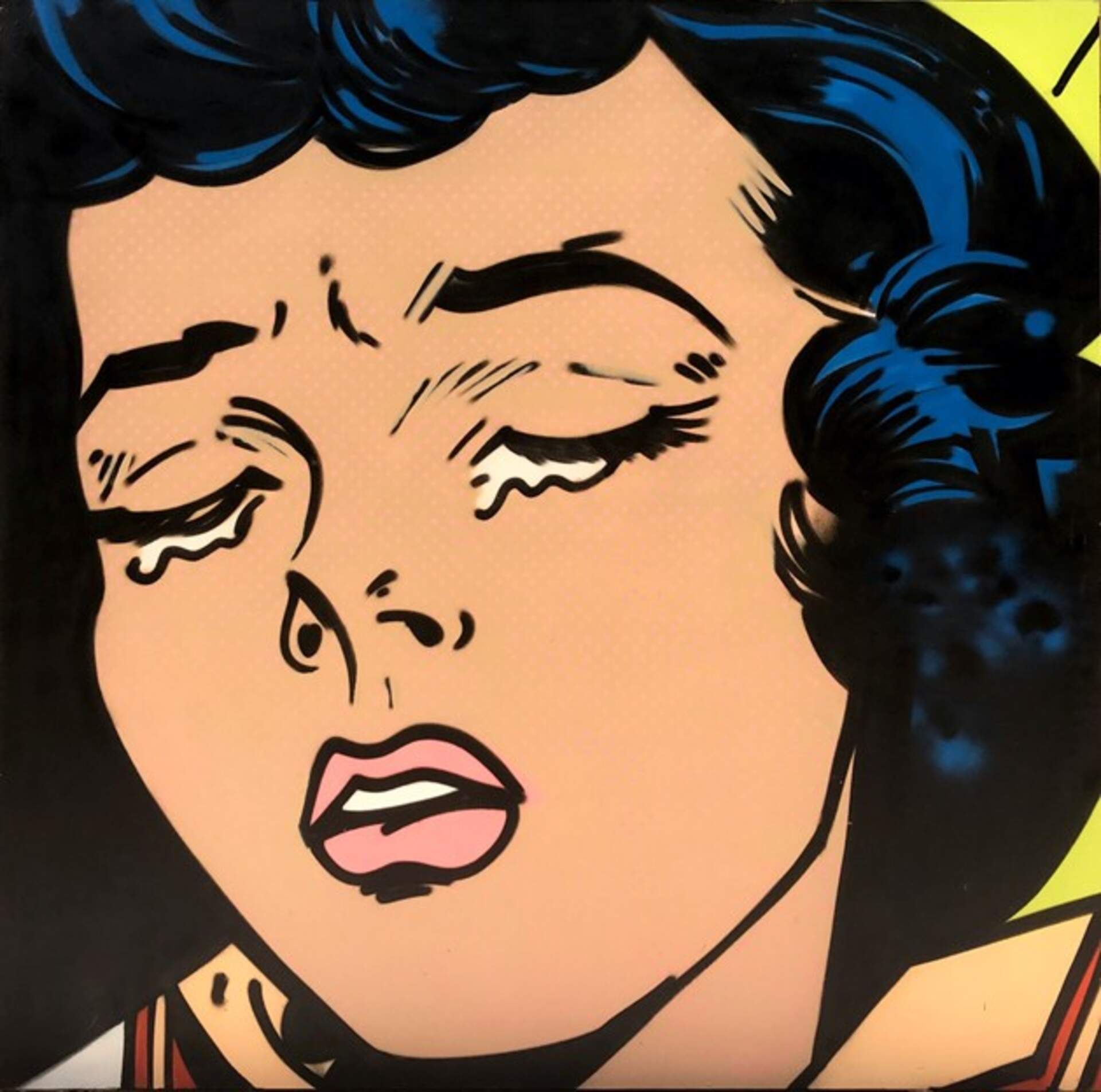Ian de Beer (Athena Page)Untitled (Sad Girl)
2014
acrylic spray paint on canvas
60 x 60 inches
Collection of the Burchfield Penney Art Center, Gift of Gift of Aaron Ott, Curator of Public Art, Albright-Knox Art Gallery, 2021
From the artist:
I am first and foremost a painter, and thus the way I think about visually representing ideas relates directly to the practices of a painter. Ever since my first painting, I’ve chased the idea of pulling the perfect line; one that is long, does not vary in width; a line that is opaque throughout and does not streak at the end. I lived in New York City for a brief time with a close friend who was a graffiti writer, and when I began painting he suggested experimenting with spray paint. I hesitated because I didn’t want to associate with the controversial connotations of graffiti, but I tried the medium anyway and found that it enabled me to paint the lines I’d always sought to paint. I work with spray paint not because I am interested in graffiti in a social context or as a form of art, but because spray paint allows me to paint the images I paint in a way that builds upon the foundations of previous painters while contributing something new to the images that I work with. The images are often references to paintings from various periods in art history or taken from popular culture, both past and contemporary.
For this series I have referenced the art of comic book artists that were producing their work in the United States post World War II. The story lines were very dramatic and often revolved around the romantic relationships between men and women and were intended to appeal to women, yet the writers and artists contributing to the comics were almost exclusively male. As a result these comics can be interpreted as a representation of the nature of women as males perceived them, or as they were understood to be based on established cultural traditions. On almost every page there is a woman depicted in a state of distress, crying or aghast, most likely in response to the actions of the male character for whom they’ve developed a dependency.
Taken out of context, this representation of the nature of women becomes silly and outdated. My practice has been to embrace it, and present it via the relatively new aesthetic of art made with spray paint, because as a woman and as an artist I’ve personally found that it is often more important to recognize and appreciate the positive qualities of the methods of perception employed by people, especially by a comparatively large demographic within society’s whole, even if it is a mistake. With painting and within my life I do not aim to change people’s minds by initiating confrontation. It is my hope that the viewer finds pleasure in the images I depict.
Old images and concepts intrinsically possess values that have relevancy when interpreting contemporary art and culture. These paintings collectively depict women crying, and I call this series the “sad girl” series, which references a current trend growing in prominence in both eastern and western youth culture. Young women and girls all over the world have been posting on various social media platforms, images of themselves wearing expressions of indifference or sorrow and using the sadgirls hashtag. As part of cultural evolution, some of the most popular music and visual art being produced currently is made by artists who take pride in being sad and the rapid spreading of this trend worldwide speaks to the condition of the internet age. There are obvious similarities to be found between my selective interest and subsequent use of these images of crying women in my paintings and the veneration of sadness espoused by those whom associate with the sadgirls/sadboys movement. This series is my contribution.
Labels by Emily Constantin, 2022:
With a soft pink smear of paint on her lips, drips on her cheeks, heavy tears, and a furrowed brow—who hurt her? Artist Ian de Beer uses spray paint to rip a 2x2 inch typical comic trope from its pages to be presented at 5x5 feet. The larger-than-life damsel in distress draws inspiration from comics written for women in the 60s and 70s, but Ian de Beer aims to take these damsels out of context to display how truly silly and outdated these ideals are. Using spray paint, he brings her to life with vibrant colors. If you remove the bubbling tears, do you perhaps see a woman tired of being hurt by someone, a person with whom they’ve formed a dependence? Someone she trusted? Or perhaps you see a woman tired of being the victim? Is she aesthetic? This painting was originally presented under the name of de Beer’s friend, Athena Page, due to extenuating circumstances with his career as a graffiti artist.
For Kids:
Have you ever seen something like this in a comic book? Who hurt her? Was it a superhero? Loved one? The villain? Who can she trust? Brimming with emotion, her tears begin to bubble over. Artist Ian de Beer wanted to take the “damsel in distress” out of comic books and present her in a true light using spray paint and vivid colors. Smeared makeup, large tears, and pink dots presented in comic book style illustration bring life to her sad expression. A blue shine to her hair glows with her emotions as bright green in corners screams her confusion or frustration. Who will help her? Maybe she doesn’t need saving because women today actively fight old stereotypes such as this and empower others.
